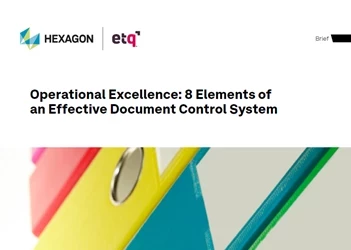Why most operational loss-reduction efforts fail & how to change that
Operational losses are a challenge for many businesses while efforts to reduce them often fall flat
Add bookmark
Operational losses are a real headache for many businesses and efforts to reduce them often fall flat. From high-end multinationals to SMEs across the globe, a staggering amount of money is invested into Lean Six Sigma and other improvement programs.
Despite these significant cash injections, McKinsey reports that around 70 percent of change programs fail to achieve their goals, largely due to resistance and lack of management support.
Leadership teams, faced with increasing cost pressures, launch ever more complex and elaborate loss-reduction programs. Many of these will achieve some quick wins, however all too often results fade and enthusiasm for the program gives way to the old way of working.
Despite the investment and early excitement around these improvement initiatives, most are destined to fail. They often end up doing more harm than good as they damage morale and make it harder for genuine and proven improvement strategies to be accepted.
Join the PEX Network community

Don't miss any news, updates or insider tips from PEX Network by getting them delivered to your inbox. Sign up to our newsletter and join our community of experts.
Learn MoreSymptom focus versus root cause focus
When looking to reduce operational losses, it is natural to focus on clear, visible issues. For example, a production line keeps stopping due to a sensor becoming contaminated with dirt. If the symptom is treated, the obvious conclusion is to clean the sensor, so that the line can be restarted.
However, what has been missed is the root cause; the reason the sensor is becoming dirty in the first place. If the source of contamination is stopped, the sensor will no longer become dirty, so the root cause of the line stop has been identified and eliminated.
The same is true for people-driven processes. If just the symptoms are addressed, i.e. a person performing an activity incorrectly, then the root cause of that behavior has not been addressed. By digging deeper, the root cause may be an insufficient training program or outdated work instructions.
Symptom focus promotes short term solutions, or ‘quick fixes.’ These often feel great at the time and indeed have their place in containing immediate production or quality issues. However, they also mean that the losses remain unsolved, and sooner rather than later the full impact of that loss is again felt, damaging morale and resulting in costly downtime, production and quality issues. According to Aberdeen Group, unplanned downtime costs industrial manufacturers an average of US$260,000 per hour.
A fundamental shift in approach is required to identify and eliminate the true root cause; this is to build organizational capability. A shift away from firefighting to embedding a culture of continuous improvement.
Register for All Access: OPEX Operational Excellence 2025!
Skip the jargon
Many improvement models such as Lean Six Sigma are difficult to relate to, especially if this is the first time someone has been exposed to this type of program. This can lead to a sense of feeling overwhelmed and disconnected. Buzzwords such as Gemba, Kaizen and Ishikawa are fine for those who have used them for many years, but to frontline workers they are often impossible to connect with.
As soon as people feel disconnected, they start to view these programs with suspicion and any sign of genuine engagement disappears. Instead, leaders need to ensure programs feature simple language and hands-on, accessible and practical methods to engage people in problem solving.
As organizational capability develops, Lean language can be reintroduced. The key difference is that people will have already used and applied these methods. The step to using Lean terminology will then be seamless as workers directly connect the new language to their own lived experience.
Ownership at the frontline, not in the office
Loss-reduction programs are often seen as ‘management initiatives.’ With little or no upfront input at frontline level, operators and engineers often feel no sense of ownership to the program or its activities. Without this, it can be a natural reaction to just ‘go through the motions’ without inputting any real value and with little or no concern for whatever result is achieved.
Frontline workers often know exactly where the real problems are, but they are insufficiently trained and don’t feel empowered to solve them. Boston Consulting Group found that firms which empower frontline employees in continuous improvement achieve 30 percent higher success rates in sustaining change. Statistics and data analysis has its place, but ignoring ‘soft data’ (what people on the frontline experience every day) means ignoring a huge piece of the real-world picture.
By promoting ownership at floor level, enhancing people’s skills through high-quality training and empowering them to take charge of problem solving, improvements become embedded in operational culture. It is this culture that will ensure the gains made are sustainable and that the program does not fail.
Lack of results connection
One of the most important elements of improvement programs that is often missed is The Why. The Why is the reason for implementing the program, the pain points that must be removed and the results that show it was successful. The Why is different for every organization and indeed will shift over time even within the same business.
Today, there may be a need to significantly reduce the number of defects from a particular process. With quality improvements now embedded, in six months’ time the focus could well be on reducing changeover time to increase agility.
Progress against The Why should be tracked by a small but relevant set of key performance indicators (KPIs). These KPIs must be highly visible and it should be immediately apparent if the program activities are not giving the desired results. Without visible metrics, it is easy for people to become demotivated and for leaders to become frustrated at a perceived lack of progress (which may or may not reflect what is actually happening).
Gallup’s research shows that organizations with highly engaged employees see 21 percent higher profitability and 17 percent greater productivity, clear proof of the link between visibility, motivation and results.
Tracking progress at every stage is a vital part of the program’s progression. Top level KPIs track the overall progress, while disseminated performance indicators can be deployed at team or activity level to support tracking at every stage. The key is to keep it simple. Every person should understand the impact they are having on the pain points, their impact on The Why.
Why your loss-reduction efforts won’t fail
Most loss-reduction programs fail because of a focus on symptoms, a lack ownership and engagement and no clear, communicated reason for their implementation. Not digging deeper to uncover the root cause, forcing action with a top-down approach and aimlessly working towards an undefined target will always result in an unsuccessful implementation which damages morale, significantly undermining future improvement efforts.
Successful efforts always start by strongly defining The Why. People at all levels of the organization understand the reasons for implementing the program, the specific pain points which are to be eradicated and a clear vision of what success looks like.
Ownership is clearly embedded at the frontline, with high quality, program-specific training empowering people to make real, sustainable improvements. Frontline workers are highly engaged, with regular feedback and celebration of achievements reinforcing their commitment to success.
By closely tracking progress with targeted, relevant KPIs and associated disseminated performance indicators, the program remains agile, with adjustments applied where needed to remain on track. Leaders remain confident in the application of activities, while frontline workers stay motivated and continue to grow a culture of continuous improvement.
Whilst many loss-reduction efforts ultimately fail, with the right ingredients it doesn’t have to be that way. What would it take for your organization to stop treating losses as ‘normal’ and start eliminating them for good?
Get Certified for Operational Excellence by Lean Dimensions International
Organizations don’t have to tackle these programs alone. Get Certified for Operational Excellence (by Lean Dimensions International) offer a City & Guilds Assured Practitioner of Operational Excellence program.
Designed for frontline workers, this highly interactive e-learning program has been developed to deliver consistent, high-quality teaching whilst minimizing the operational downtime associated with traditional classroom training.
An expert assessed practitioner project ensures practical application, while additional learner cohort coaching locks in learning standards. Leadership workshops and development sessions ensure a joined-up solution for any improvement program, developing The Why, supporting program leadership and embedding organizational capability.
All Access: Future of BPM 2026

You asked, and we listened. Business process management (BPM) remains the cornerstone technology for driving organizational transformation, according to the survey results featured in the latest PEX Report. As we look toward 2026 and beyond, generative AI, agentic AI, and intelligent process orchestration are redefining how processes are designed, executed, and optimized. BPM is your key to adapting swiftly and effectively in this new era.
PEX Network is bringing together industry leaders, technology innovators, and thought leaders to answer your biggest questions and explore the advancements reshaping business today. And you're invited. Register for free to save your spot now!
Register Now













